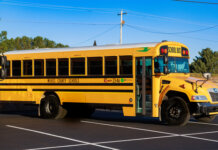In conjunction with Highland Electric Fleets and National Grid, a Thomas Built Buses Saf-T-Liner C2 Jouley electric school bus equipped with a Proterra battery system discharged nearly 3 MWh of electricity to the regional electric grid over the course of 30 events this summer in Beverly, Mass.
This is the first time an electric school bus has been leveraged as an energy resource by the regional utility National Grid in New England and among the first instances in the U.S. that an electric school bus has supported the electric grid in this way.
Highland – which provides the bus, chargers and all electricity to Beverly Public Schools under a mileage-based subscription – worked with National Grid to ensure that the site was prepared for energy discharge and coordinated participation in their Connected Solutions Daily Dispatch program. Under this program, National Grid utilized the energy stored in the electric school bus battery on 30 different occasions over the summer to lower demand on the grid during times of peak demand.
“Highland is thrilled to be a part of this groundbreaking program as the integrator of industry-leading technology, forward thinking energy policy and tremendous community leadership to solve some of the country’s toughest challenges,” says Duncan McIntyre, CEO of Highland. “We’re so honored to support those on the ground making amazing stories like this come to reality every day.”
“By delivering stored clean energy back to the grid when it’s needed most, electric school buses can help create a more resilient local power system and reduce the dependence on expensive fossil fuel power plants,” mentions Gareth Joyce, president of Proterra. “Switching to zero-emission, electric school buses signals a transformational shift towards clean transportation and clean energy to help protect the health of our children and the communities they live in.”
Thomas Built’s Saf-T-Liner C2 Jouley with Proterra’s bidirectional charging system managed the charging and discharging of the electric school bus back into the grid.
By sending electricity back to the grid when demand for electricity was at its highest and most expensive, the school bus helped reduce local emissions and decreased the need to fire up costly fossil fuel “peaker” plants. National Grid compensates participants in this program for their energy services, incentivizing the use of distributed energy resources to strengthen the local grid.
Participation in National Grid’s program marks an important step in closing the up-front cost gap between traditional diesel school buses and electric school buses, as revenue from vehicle-to-grid (V2G) programs offer a unique means to improve the economics of electric school bus ownership.
The average school bus transports students for approximately six hours a day, 200 days annually, and are otherwise parked or idled when not in operation. This is particularly true during summer months, when demand for electricity is often at its highest and clean energy stored in idled electric school buses can provide an energy resource to the grid.
“We are proud to have added several customers and vendors to our programs this year that are using vehicle-to-grid technology,” comments John Isberg, vice president of customer sales and solutions at National Grid. “This underlines the strength of the technology neutral approach of the Connected Solutions Daily Dispatch program. Through this single program we have enrolled batteries, fuel cells, thermal storage, V2G and many other technologies without needing to confuse customers and vendors with separate programs and incentives for each technology.”
In Beverly, Highland provided a turnkey, fixed-price subscription that eliminated up front cost, risk and complexity of managing the electric school bus, and allowed Beverley to benefit from the V2G services provided by the bus through a lower subscription price. This type of public-private partnerships allows school districts to capture the value of a V2G program and fully unleash the potential of electric school buses.
The Saf-T-Liner C2 Jouley couples 226 kWh of total energy capacity from Proterra’s industry-leading battery technology, the highest standard battery capacity in the industry, with a Proterra electric drivetrain to offer unparalleled energy efficiency and up to 135 miles of drive range to meet the needs of school bus fleets.





